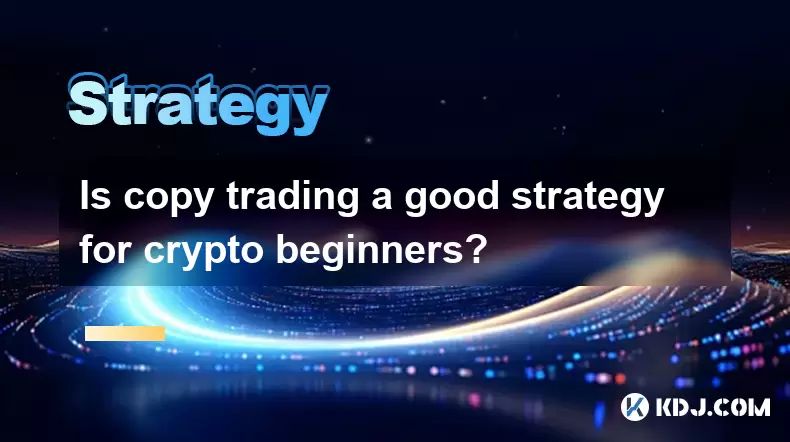-
 bitcoin
bitcoin $120167.907534 USD
1.27% -
 ethereum
ethereum $4468.611945 USD
2.53% -
 xrp
xrp $3.013607 USD
1.80% -
 tether
tether $1.000549 USD
-0.01% -
 bnb
bnb $1092.592149 USD
6.28% -
 solana
solana $231.391244 USD
4.59% -
 usd-coin
usd-coin $0.999699 USD
-0.04% -
 dogecoin
dogecoin $0.259020 USD
4.30% -
 tron
tron $0.342747 USD
0.34% -
 cardano
cardano $0.860977 USD
1.07% -
 hyperliquid
hyperliquid $50.155412 USD
5.34% -
 chainlink
chainlink $22.637678 USD
0.46% -
 ethena-usde
ethena-usde $1.000528 USD
-0.07% -
 avalanche
avalanche $30.613779 USD
-0.07% -
 stellar
stellar $0.403905 USD
0.94%
Is copy trading a good strategy for crypto beginners?
Copy trading lets beginners mirror experienced crypto traders, offering a way to learn and invest without deep market knowledge.
Jul 12, 2025 at 08:28 am

Understanding Copy Trading in the Cryptocurrency Market
Copy trading is a strategy where novice traders replicate the trades of experienced investors automatically. In the context of cryptocurrencies, this method allows beginners to mirror the actions of seasoned traders through platforms that offer such services. The appeal lies in the ability to gain exposure to the market without needing extensive knowledge or time for research.
This approach has gained popularity due to the volatility and complexity of the crypto market. Platforms like eToro, Binance, and Bybit have integrated copy trading features to cater to users who are new to digital assets. Beginners can select a trader based on performance metrics, risk levels, and trading frequency, then allocate funds to follow their activities.
However, it's important to understand that while copy trading can lower the learning curve, it does not eliminate risks. The success of this strategy heavily depends on the performance of the trader being followed and the user’s understanding of how the system works.
How Copy Trading Works on Crypto Platforms
The mechanics behind crypto copy trading involve linking your account with that of an expert trader via a platform. Once linked, every trade executed by the expert is automatically copied into the follower’s account, proportionally adjusted based on the allocated investment amount.
- Users must first choose a reliable copy trading platform.
- They browse through available traders using filters like profit history, drawdown, and risk score.
- After selecting a trader, they allocate a portion of their portfolio to mirror the trader's positions.
- The platform handles the execution and adjusts the copied trades in real-time.
It's crucial to monitor the performance of the trader continuously. Some platforms allow setting stop-loss limits or allocating fixed amounts per trade. Beginners should also be aware of fees involved, which may include subscription costs or performance-based charges.
Risks Associated with Copy Trading for Newcomers
While copy trading can simplify entry into crypto markets, it comes with significant risks that beginners might overlook. One major concern is over-reliance on a single trader. If the selected trader makes a poor decision or experiences a sudden loss, followers will suffer similar consequences.
Another risk is the lack of customization. Since trades are copied directly, users might end up holding assets that don't align with their personal investment goals or risk tolerance. Additionally, market volatility can lead to rapid losses if the copied trader uses leverage or speculative strategies.
There’s also the possibility of encountering fake or manipulated profiles on some platforms. Traders with impressive short-term gains might not sustain those results over time. Beginners should verify track records and avoid chasing high returns without understanding the underlying strategies.
Benefits of Copy Trading for Crypto Novices
Despite the risks, there are clear advantages for beginners exploring the crypto space. One of the most notable benefits is access to professional strategies without requiring in-depth market knowledge. This can help newcomers learn by observing how experienced traders manage their portfolios.
Another benefit is time efficiency. Researching market trends, analyzing charts, and tracking news can be overwhelming for new users. Copy trading allows them to participate actively without dedicating hours to study the market daily.
Moreover, many platforms provide educational resources alongside copy trading tools. These materials help users understand why certain trades are made, enabling gradual skill development. Over time, this can empower beginners to make independent decisions rather than relying solely on others.
Choosing the Right Trader to Follow
Selecting a suitable trader is one of the most critical steps in successful copy trading. Beginners should focus on several key indicators before committing funds.
- Examine the trader’s historical performance across different market cycles.
- Look at the risk-to-reward ratio and average return percentage.
- Check the consistency of profits instead of short-term spikes.
- Assess the trading style—whether it's day trading, swing trading, or long-term investing.
- Consider the number of active followers and whether other users trust the trader.
Some platforms offer detailed analytics and transparency reports, making it easier to evaluate potential candidates. Beginners should start with small investments and gradually increase their allocation as they become more confident in their choice.
Frequently Asked Questions
Can I lose money with copy trading?Yes, just like any investment, copy trading carries financial risk. If the trader you're following incurs losses, those will be reflected in your account. It's essential to diversify and not allocate all funds to a single trader.
Do I need prior trading experience to use copy trading?No, copy trading is designed for users with little to no experience. However, having a basic understanding of how markets work can help in choosing the right trader and managing expectations.
Are there fees associated with copy trading?Most platforms charge either a subscription fee or a performance-based commission. Always check the fee structure before committing funds to ensure it aligns with your budget and goals.
Can I stop copying a trader anytime?Yes, users can disconnect from a trader at any moment. Any open positions will remain until closed manually or by the trader, but no new trades will be copied after disconnection.
Disclaimer:info@kdj.com
The information provided is not trading advice. kdj.com does not assume any responsibility for any investments made based on the information provided in this article. Cryptocurrencies are highly volatile and it is highly recommended that you invest with caution after thorough research!
If you believe that the content used on this website infringes your copyright, please contact us immediately (info@kdj.com) and we will delete it promptly.
- BlockDAG, DOGE, HYPE Sponsorship: Crypto Trends Shaping 2025
- 2025-10-01 00:25:13
- Deutsche Börse and Circle: A StableCoin Adoption Powerhouse in Europe
- 2025-10-01 00:25:13
- BlockDAG's Presale Buzz: Is It the Crypto to Watch in October 2025?
- 2025-10-01 00:30:13
- Bitcoin, Crypto, and IQ: When Genius Meets Digital Gold?
- 2025-10-01 00:30:13
- Stablecoins, American Innovation, and Wallet Tokens: The Next Frontier
- 2025-10-01 00:35:12
- NBU, Coins, and Crypto in Ukraine: A New Yorker's Take
- 2025-10-01 00:45:14
Related knowledge

Practical parameter settings for a Bitcoin multi-timeframe moving average system
Sep 18,2025 at 10:54pm
Optimizing Timeframe Combinations for Bitcoin Trading1. Selecting appropriate timeframes is crucial when building a multi-timeframe moving average sys...

How can I filter out false breakouts in Dogecoin high-frequency trading?
Sep 22,2025 at 01:00am
Understanding False Breakouts in Dogecoin Trading1. A false breakout occurs when Dogecoin's price appears to move beyond a defined support or resistan...

Techniques for identifying tops and bottoms in the Bitcoin on-chain NVT model
Sep 20,2025 at 07:54pm
Understanding the NVT Model in Bitcoin Analysis1. The Network Value to Transactions (NVT) ratio is often described as the 'P/E ratio' of the cryptocur...

What does the surge in open interest in Bitcoincoin futures mean?
Sep 20,2025 at 11:18pm
Understanding the Surge in Dogecoin Futures Open Interest1. A surge in open interest within Dogecoin futures indicates a growing number of active cont...

How can I use the Ethereum USDT premium to gauge market sentiment?
Sep 18,2025 at 11:55pm
Understanding the Ethereum USDT Premium1. The Ethereum USDT premium refers to the price difference between USDT (Tether) traded on Ethereum-based plat...

What should I do if Ethereum staking yields decline?
Sep 20,2025 at 06:18am
Understanding the Causes Behind Declining Ethereum Staking Yields1. The Ethereum network transitioned to a proof-of-stake consensus mechanism with the...

Practical parameter settings for a Bitcoin multi-timeframe moving average system
Sep 18,2025 at 10:54pm
Optimizing Timeframe Combinations for Bitcoin Trading1. Selecting appropriate timeframes is crucial when building a multi-timeframe moving average sys...

How can I filter out false breakouts in Dogecoin high-frequency trading?
Sep 22,2025 at 01:00am
Understanding False Breakouts in Dogecoin Trading1. A false breakout occurs when Dogecoin's price appears to move beyond a defined support or resistan...

Techniques for identifying tops and bottoms in the Bitcoin on-chain NVT model
Sep 20,2025 at 07:54pm
Understanding the NVT Model in Bitcoin Analysis1. The Network Value to Transactions (NVT) ratio is often described as the 'P/E ratio' of the cryptocur...

What does the surge in open interest in Bitcoincoin futures mean?
Sep 20,2025 at 11:18pm
Understanding the Surge in Dogecoin Futures Open Interest1. A surge in open interest within Dogecoin futures indicates a growing number of active cont...

How can I use the Ethereum USDT premium to gauge market sentiment?
Sep 18,2025 at 11:55pm
Understanding the Ethereum USDT Premium1. The Ethereum USDT premium refers to the price difference between USDT (Tether) traded on Ethereum-based plat...

What should I do if Ethereum staking yields decline?
Sep 20,2025 at 06:18am
Understanding the Causes Behind Declining Ethereum Staking Yields1. The Ethereum network transitioned to a proof-of-stake consensus mechanism with the...
See all articles










































































